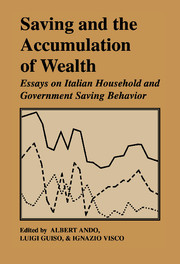Book contents
- Frontmatter
- Contents
- Foreword by Antonio Fazio
- List of contributors
- List of figures
- List of tables
- Acknowledgments
- Introduction
- I Saving trends, government deficit and demographic changes
- 1 Why is Italy's saving rate so high?
- 2 Private saving and the government deficit in Italy
- 3 Do demographic changes explain the decline in the saving rate of Italian households?
- 4 Generational accounting. The case of Italy
- II Life-cycle saving and precautionary motives
- III Borrowing constraints, intergenerational transfers and bequests
- Appendixes
- Index
3 - Do demographic changes explain the decline in the saving rate of Italian households?
Published online by Cambridge University Press: 05 May 2010
- Frontmatter
- Contents
- Foreword by Antonio Fazio
- List of contributors
- List of figures
- List of tables
- Acknowledgments
- Introduction
- I Saving trends, government deficit and demographic changes
- 1 Why is Italy's saving rate so high?
- 2 Private saving and the government deficit in Italy
- 3 Do demographic changes explain the decline in the saving rate of Italian households?
- 4 Generational accounting. The case of Italy
- II Life-cycle saving and precautionary motives
- III Borrowing constraints, intergenerational transfers and bequests
- Appendixes
- Index
Summary
Introduction
The 1980s witnessed a worrying decline in the propensity to save of Italian households; official estimates report a decrease in the personal saving rate of more than 4 percentage points in the last decade (from 20.6 in 1979–1981 to 16.3 per cent in 1989–1990). Several causal factors might, theoretically, have been at work. Some of them have been thoroughly investigated; Rossi and Visco (1994), for instance, emphasize the role of social security, while Guiso, Jappelli and Terlizzese (1994) examine the interaction between growth and capital market imperfections in order to understand the pattern of Italian saving. In this paper I focus on the effects of demographic changes.
Saving rates may differ across households because of differences in family composition. For example, the cost of providing for children may have a significant impact on consumption needs; household size may affect the propensity to save, as larger households may benefit from economies of scale in consumption. Moreover, according to the life–cycle theory, the propensity to consume should vary over the lifetime, being low before retirement and increasing thereafter. Therefore, changes in the structure of the population might be expected to help explain the decline in the saving rate.
Several studies examine the effects on saving of demographic changes. Davies (1988) explores the consequences of incorporating family size in life–cycle models.
- Type
- Chapter
- Information
- Saving and the Accumulation of WealthEssays on Italian Household and Government Saving Behavior, pp. 106 - 127Publisher: Cambridge University PressPrint publication year: 1994
- 2
- Cited by

